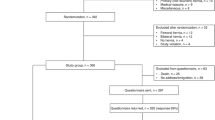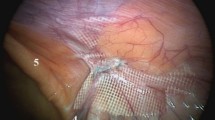Abstract
Purpose
Umbilical and epigastric hernia repairs are minor, but are commonly conducted surgical procedures. Long-term results have only been sparsely investigated.
Our objective was to investigate the risk of chronic complaints after a simple sutured repair for small umbilical and epigastric hernias.
Methods
A retrospective cohort study with a 5-year questionnaire and clinical follow-up was conducted. Patients undergoing primary elective, open non-mesh umbilical or epigastric sutured hernia repair were included. Patients completed a structured questionnaire regarding chronic complaints during work and leisure activities using a verbal rating scale. The primary outcome was chronic complaints.
Results
A total of 295 patients were included for analysis after a median of 5.0-year (range 2.8–8.0) follow-up period. Follow-up results were achieved from 262 of the included patients (90 % response rate). Up till 5.8 % of the patients reported moderate or severe pain and discomfort. Work and leisure activities were restricted in 8.5 and 10.0 % of patients, respectively. Patients with chronic complaints had a higher incidence of recurrence (clinical and reoperation), than patients with none or mild complaints (78.6 vs. 22.2 % (P < 0.001)). The recurrence rate was significantly higher after a repair with absorbable suture (20.1 %) compared with non-absorbable suture repair (4.2 %) (P < 0.001).
Conclusion
We found that chronic complaints after a simple sutured umbilical or epigastric repair was in the level of 5.5 % and could in part be explained by recurrence. Furthermore, absorbable suture should be omitted to reduce risk of recurrence.

Similar content being viewed by others
References
Sauerland S, Walgenbach M, Habermalz B, Seiler CM, Miserez M (2011) Laparoscopic versus open surgical techniques for ventral or incisional hernia repair. Cochrane Database Syst Rev 16, CD007781
Witherspoon P, O’Dwyer PJ (2009) Surgeons’ perspectives on options for ventral abdominal hernia repair: results of a postal questionnaire. Hernia 9:259–262
Aslani N, Brown CJ (2010) Does mesh offers an advantage over tissue in the open repair of umbilical hernias? A systematic review and meta-analysis. Hernia 14:455–462. doi:10.1007/s10029-010-0705-9
Arroyo A, García P, Pérez F, Andreu J, Candela F, Calpena R (2001) Randomized clinical trial comparing suture and mesh repair of umbilical hernia in adults. Br J Surg 88:1321–1323. doi:10.1046/j.0007-1323.2001.01893.x
Halm JA, Heisterkamp HF, Weidema WF (2005) Long-term follow-up after umbilical hernia repair: are there risk factors for recurrence after simple and mesh repair. Hernia 9:334–337. doi:10.1007/s10029-005-0010-1
Erritzøe-Jervild L, Christoffersen MW, Helgstrand F, Bisgaard T (2013) Long-term complaints after elective repair for small umbilical or epigastric hernias. Hernia 17:211–215. doi:10.1007/s10029-012-0960-z
Iversen E, Lykke A, Hensler M, Jorgensen LN (2010) Abdominal wall hernia repair with composite ePTFE/polypropylene mesh: clinical outcome and quality of life in 152 patients. Hernia 14:555–560. doi:10.1007/s10029-010-0729-1
Venclauskas L, Silanskaite J, Kiudelis M (2008) Umbilical hernia: factors indicative of recurrence. Med (Kaunas) 44:855–859
Polat C, Dervisoglu A, Senyurek G, Bilgin M, Erzurumlu K, Ozkan K (2005) Umbilical hernia repair with the prolene hernia system. Am J Surg 90:61–64. doi:10.1016/j.amjsurg.2004.09.021
Asolati M, Huerta S, Sarosi G, Harmon R, Bell C, Anthony T (2006) Predictors of recurrence in veteran patients with umbilical hernia: single center experience. Am J Surg 192:627–630. doi:10.1016/j.amjsurg.2006.08.022
Farrow B, Awad S, Berger DH, Albo D, Lee L, Subramanian A, Bellows CF (2008) More than 150 consecutive open umbilical hernia repairs in a major Veterans Administration Medical Center. Am J Surg 196:647–651. doi:10.1016/j.amjsurg.2008.07.018
Sanjay P, Reid TD, Davies EL, Arumugam PJ, Woodward A (2005) Retrospective comparison of mesh and sutured repair for adult umbilical hernias. Hernia 9:248–251. doi:10.1007/s10029-005-0342-x
Aasvang E, Kehlet H (2005) Chronic postoperative pain: the case of inguinal herniorrhaphy. Br J Anaesth 95:69–76. doi:10.1093/bja/aei019
Bay-Nielsen M, Perkins FM, Kehlet H, Danish Hernia Database (2001) Pain and functional impairment 1 year after inguinal herniorrhaphy: a nationwide questionnaire study. Ann Surg 233:1–7. doi:10.1097/00000658-200101000-00001
Nordin P, Haapaniemi S, Kald A, Nilsson E (2003) Influence of suture material and surgical technique on risk of reoperation after non-mesh open hernia repair. Br J Surg 90:1004–1008
Conflicts of interest
No authors have conflicts of interest regarding the present study.
Author information
Authors and Affiliations
Corresponding author
Additional information
The study was approved by the Danish Data Protection Agency (reg. no. 2008-58-0020) and the Ethics Committee of the Capital Region (reg.no.: KF07329141), and registered by clinicaltrials.gov (ID: NCT0174740).
Rights and permissions
About this article
Cite this article
Westen, M., Christoffersen, M.W., Jorgensen, L.N. et al. Chronic complaints after simple sutured repair for umbilical or epigastric hernias may be related to recurrence. Langenbecks Arch Surg 399, 65–69 (2014). https://doi.org/10.1007/s00423-013-1119-9
Received:
Accepted:
Published:
Issue Date:
DOI: https://doi.org/10.1007/s00423-013-1119-9




